
The Best of Everything
Encyclopedia Entry • Films Main
The Damned Don't Cry
1950

Critics' Reviews • Our Reviews • Movie Posters • Lobby Cards • Misc. Images
Click here to see photos from the film.
US theatrical release: 5/13/50.
Region 1 DVD release: 6/14/05. Warner Archive Blu-ray release: 6/27/2023. Cast: Joan Crawford (as "Ethel Whitehead/Lorna Hansen Forbes"), David Brian, Steve Cochran, Kent Smith, Hugh Sanders, Selena Royle, Jacqueline de Wit, Morris Ankrum, Edith Evanson, Richard Egan, Jimmy Moss, Sara Perry, Eddie Marr. Credits: Story by Gertrude Walker (based partly on story "The Brooch," by William Faulkner, who was uncredited and also wrote a treatment for the film). Screenplay: Harold Medford and Jerome Weidman. Producer: Jerry Wald. Director: Vincent Sherman. Camera: Ted McCord. Art Director: Robert Haas. Music: Daniele Amfitheatrof. Wardrobe: Sheila O'Brien. Editor: Rudi Fehr. Plot Summary: A woman's desire to rise above her drab lower middle-class life takes her down the road to destruction in this gripping crime melodrama. The story opens as she cowers insider her old home, fearing the inevitable arrival of the murderous gangsters pursuing her. Her tragic tale unfolds via flashback. It all began when she became frustrated by her humble life in a squalid factory town. She was married to a laborer and lived with her parents. Soon after her child accidentally dies, the distraught woman abandons her old life to take a job where she meets an exceptional, but dull as dishwater accountant. He is a bit spineless and so allows the woman to convince him to get involved with a powerful gangster. Though she had promised to marry the accountant, she reneges and becomes the illicit moll of the married gangster. Wanting her to be a bit more elegant so he can pass her off as a Texas heiress to his west-coast rival, the gangster hires an impoverished socialite to teach her social graces. Soon she appears as an elegant, cultured woman. Still, despite her sophisticated exterior, she is conniving and ruthless inside and tries to double-cross both her new lover and his rival. Eventually the two crime lords meet in a bloody confrontation that leaves one mobster dead. Her lover is about to shoot her but the accountant (who still loves her) intervenes and she escapes back to her home town. She waits there through the night and the next morning goes outside and finds her gangster lover waiting to get his revenge. ~ Sandra Brennan, All Movie Guide Film Notes: • In an interview with Joan biographer Charlotte Chandler, director Vincent Sherman said that the film, originally titled The Victim, was based on the life of gangster Bugsy Siegel's mistress Virginia Hill. (Joan Crawford: Not the Girl Next Door) • Frank Sinatra's Palm Springs home was used to film the scenes at gangster Cochran's hideout. (AFI) • Joan and Frank Lovejoy later performed a radio version of the story on the Screen Directors' Playhouse program (April 5, 1951). (AFI)
|
Bosley Crowther in the New York Times April 8, 1950
A lengthy and lurid illustration of the thesis that crime does not pay and that ladies who dance with mobsters must fee the fiddler in the end is offered by Warner Brothers in their new film, "The Damned Don't Cry," which has Joan Crawford as the victim and which came to the Strand yesterday. Take the old true-confession formula, slick it up with some synthetic "class" and top it with gangster-film violence and you have yourself a notion of this show. For here we have sin and its wages (which are not too exorbitant, by the way) put forth in the old familiar pattern of make-believe "reality." Here we have Miss Crawford playing a frustrated laborer's wife who leaves her miserable surroundings for a self-aggrandizing career, working up in an underworld environment to the role of "fancy lady" to a big gang boss and then crashing back to the place of her origin when a mobsters' feud wipes out her man. And here we have, too, a prime example of that sort of commercial hypocrisy which endows an obvioutevildoer with glamor and sympathy. Miss Crawford as the "fancy lady" runs through the whole routine of cheap motion-picture dramatics in her latter-day hard-boiled, dead-pan style. As a laborer's wife, she plays it without make-up and with her face heavily greased (although fake eyelashes are still retained as a customary embellishment of a laborer's wife). As a cigar-store clerk and clothes model, she plays it tough—you know, speaks the tough guy's line and looks the mere men squarely and coldly in the face. And as the ultimately cultivated "lady" she gives it all the lofty dignity that goes with champagne buckets and Palm Springs swimming pools. A more artificial lot of acting could hardly be achieved. However, the men who support her run her a very close race. David Brian as the modern big-time gang lord to whom the lady hitches her star looks and acts like the big-city villain in back-country traveling tent show. When he comes to a line such as this one, "I like a woman who has brains, but when she also has spirit, that excites me," he virtually ends it with a lecherous "hey-hey!" And Kent Smith, as a public accountant whom Miss Crawford lures into the syndicate, plays a Milquetoast so completely that his whole performance seems a succession of timid gulps. Steve Cochran as a tricky West Coast mobster and Selena Royle as a cagrant socialite do their jobs in a conventional B-story, A-budget way. Vincent Sherman's direction is as specious as the script.
Howard Barnes in the New York Herald Tribune (1950): The scenario has given Miss Crawford ample scope to emote and show her charms. If it is contrived, it is because the theme is shabby and the incidents too violent for complete plausibility.
Glenn Erickson from TrailersFromHell.com (2023, upon Blu-ray release): When does ‘tough and brassy’ become ‘camp and kitsch’? No longer a Gorgeous Young Thing, Joan Crawford walked a narrow line when reinventing her screen image. Her best noir after Mildred Pierce is this underworld pastiche that turns the notorious Virginia Hill into Gangland USA’s most glamorous, high-toned mobster girl. The extreme histrionics never stop, what with Joan effortlessly wrapping suspicious characters David Brian, Steve Cochran and Kent Smith around her greedy fingers. The presentation includes a candid commentary from the film’s director, Vincent Sherman.... |
If you've seen The Damned Don't Cry and would like to share your review here, please e-mail me. Include a photo of yourself or avatar, a star rating (with 5 stars the best), and any of your favorite lines from the film.
|
Rating:
A Joan Crawford tour de force. I LOVE this film.
When I first saw this movie, I immediately thought of the real-life story of gangster Bugsy Siegel and his girlfriend Virginia Hill. The movie starts off when Joan is a harried, frumpish housewife with a lumpish husband. After her child dies, she packs up her few rags and moves to the city, looking for a better life. We get a super-fabulous glimpse of what the 7th Ave. rag trade used to be like back in the day. Joan becomes an ambitious 7th Ave. clothes model who, after she gets wiser, moves up the ladder and meets a sweet, trusting CPA (Kent Smith), who adores her. But Joan wants more than moon-June love. Thru the CPA, she meets a wise-guy boss (David Brian), who encourages her to change into a more cultivated society girl. Joan is totally gaga over this guy, but he's married and can't/won't take the next step to make her his wife. He then asks her to practically prostitute herself for him by meeting his gangster rival (Steve Cochran) and keeping him updated on what the rival is doing. The Bugsy/Cochran character is a good-looking, violent mobster who falls for Joan so hard that he asks her to become his wife. Of course, by this time, Joan has feelings for him, too. I don't want to give the whole movie away. But it's a great Warner Brothers movie torn from the newspaper headlines. Beautifully photographed, with Joan looking like a million bucks.
Rating:
Is this a Warners "crime noir" that should have been cast with Humphrey Bogart in the David Brian role and a minor actress? Or is it the story of a woman trying to make it in a man's world? This film can't seem to decide. Ultimately, based on the force of personality, it's a "Joan Crawford picture"---but a harsh one that includes Joan's character being given a nasty beating at one point. (Not even in most noirs does such a graphic beating of a woman take place---perhaps a fetish of director Vincent Sherman, whom Joan was sexually involved with at the time.)
There's so much going on here with Joan's character that the whole film is a bit of a hodge-podge (albeit an entertaining one), though the rapid switches in tone are more the result of director/writing/cutting than of Joan's acting.
The film starts out with a murder (similar in flashback style to the opening murder scene in Mildred Pierce), and then flashes back to a woman who might have been involved with the murder: "Police Fear Texas Oil Heiress Victim of Crime Syndicate" reads one headline. We're then taken through scenes of the police and the press investigating: "Who is Lorna Hansen Forbes? Where is she? Where did she come from?"
Cut to a bedraggled (albeit in furs) LHF driving up to her parents' home asking for shelter... Not so well-received by Pa, mitigated by Ma. When the Prodigal Ethel/Lorna sees a photo of herself, husband, and child, the flashback to the whole movie begins...
In short: Joan's "Ethel Whitehead" was once a small-town drudge of a housewife who left her skinflint husband after their child was run over and killed (after the husband didn't want to pay for the bike that Ethel had just bought the kid). Says Ethel after the funeral: "I want something more than what I've had out of life. And I'm going to get it."
She takes a bus to NYC and gets a job as a dress model, which entails entertaining out-of-town buyers. And soon becomes a hardened expert at earning extra money from her "dates." At this point, she comes on to a meek company accountant (Kent Smith as "Marty") and convinces him to start doing the books for the mob bosses that run her garment industry---so she can get a cut of his money.
There are various gangster plot machinations after this point: David Brian's George is a pretentious (he knows his Etruscan vases, though he comes from low origins himself) married mob boss that Ethel finds much sexier and richer than Marty. Ethel becomes George's "kept woman"---changing her name from "Ethel Whitehead" to "Lorna Hansen Forbes" and inventing an entirely new identity for herself, as an alleged socialite. (A much-rougher version of a similar situation, from a gentler time, in 1931's "Possesed.")
All is well until gangland wars go bad and George sends her off to California to sleep with his gangster rival, Nick (Steve Cochran). George's,willingness to let her sleep with his rival is indicative to Ethel/Lorna that he doesn't truly love her. Once Lorna meets Nick in CA, she's smitten with him because he's as "down-to-earth" as she is----every grievance that he's felt about his sordid background is something that she's also felt, and identifies with.
Per the gangland stuff, we see where all of this going, and why the dead body at the beginning of the film. But this wasn't really the point. At the very end of the film, after Ethel has returned home to her plain roots, and both George and Marty have followed her there, and a gun battle has ensued, a couple of reporters have a conversation:
"It must be pretty tough livin' in a place like this." "Tougher to get out. Think she'll try again?" "Wouldn't you?"
Joan is interesting here. While the cuts between her various lives are sudden, that's not her fault. She's appropriately drab in her housewife life, briefly humble in the 5 minutes or so of her new life in the big city, then subsequently brassy and cocky as hell when she comes on to the Accountant and proceeds to forcefully invent her new life among the bigwig Mob bosses. Her close-ups with David Brian are worthy of previous years in much more glamorous movies.
Rating:
The Damned Don’t Cry was one of the first post-MGM Joan films I ever watched, and it remains a favorite. This 1950 flick is '30s Shop Girl JC teleported 15 years into the future with crisp film noir dialogue and camera work.
Joan transforms herself from downtrodden wife of a loser in the oil patch to Fashion District model/escort to CPA’s girlfriend to gangster’s moll to Texas oil heiress with a mystery past, all accomplished with her usual one-two punch of gumption and sex appeal.
The supporting cast is very good, in particular Steve Cochran (he was Big Ed in the Cagney classic White Heat). David Brian, who was in several Joan pictures of the period, is a slick hood who polishes up Joan’s image, readying her for life as a high society vixen. Kent Smith is the accountant led astray by Joan. He comes across a bit meek, but that’s what you expect from an accountant, no?
One comment I have seen in online reviews is the improbability that all younger men in Damned go immediately gaga over 45-year-old Joan’s charms. First, there’s just so much story and backstory one can pack into 103 minutes. Second, Joan looks great. You’d think she was a latter-day Polly Moran or something (inside joke, read Billie Haines's excellent biography “Wisecracker”). JC is trim, fit, shot exceedingly well by 3-time Oscar nominee Ted McCord, with hair by Perc Westmore of “House of Westmore” fame, and clothes by Sheila O’Brien.
Not convinced? Exhibit A: Joan as dress model/escort early in Damned. https://www.joancrawfordbest.com/50damned13sep1.htm
Exhibit B: Joan with her best looking tan this side of the Doug Jr days. Maybe being a cougar wasn’t as popular then as it is now, or perhaps this is another trend Joan started, but to borrow a line from her character in Strange Cargo, the 30-something version of me would eagerly cut himself a piece of cake like that!
At 103 minutes, this is one of the longer Joan flicks I have sat through, but it is well paced. The direction by Vincent Sherman is good. It's said that he and JC were having an affair at the time, so maybe that helped. If nothing else, Joan's complexion looks great in Damned!*
My favorite post-MGM Joan flick thus far. Well acted, good production values, entertaining.
*Joan is famously quoted as saying she needed sex for a clear complexion.
Rating: 1950
was another great year for Hollywood movies despite the drop in box-office receipts and political drama and the furniture that stares back...television
(that’s how Jack Warner felt; I just love that line!) Warner
Brothers provids their standard fare here: a gangster movie
with love loss, hate, power, money, glamour, murder, death and Miss
Joan Crawford.....and her four leading men! Four! Also on board was a chief motivator,
producer Jerry Wald (Mildred Pierce), who always worked
hard for success, and the Golden Age actors who still wanted to keep
working. Hollywood was hanging on by a thread. The people involved
were talented and not ready to let go of filmmaking. Cameraman Ted McCord,
with a long resume of four Crawford movies, and
the crew were some of the best; they worked hard to give this film a harsh
reality in grand Warner Brothers style. That
Miss Crawford is twenty years older than what the
script asks for doesn't bother me in the least; however, it could
have been a role for Marilyn, Lana, Jean Simmons, Dorothy Malone, or Jean Peters.
Miss
Crawford's character is a woman who goes from Ethel Whitehead to Lorna
Hansen Forbes...but who exactly is Lorna Hansen Forbes? The story by Gertrude
Walker gets right to the point with a brief flashback: The opening, filmed in noir
style, sets the audience up with all of the back
story, including a corpse being thrown out of the car in the
desert (the sunlight just right) and a Palm Springs home with the latest
in 1950 decor, including an Asian butler complete with white jacket (just
like Ito in Mame). But first we have to meet Ethel Whitehead, a housewife and
mother, who lives with her parents in an ugly, drab, dirt-poor
factory town and has a husband who merely gets by with the grime of a life. Small-time
husband Richard Egan (Demetrius and the
Gladiators 1954) is a total hunk, but his character is a real cranky,
macho, old-fashioned, tight-fisted, backward male. Trouble and suffering come along right away for Miss Crawford. Ethel just wants something better for her kid; in this case, a bicycle. But no! Egan is just like Burt in Mildred; he won't face up to the fact he is a stingy loser and doesn’t want to change anything or pay for it for that matter and he demands the bike taken away from his son. But before he has his hands on it, the boy gets run over by a truck! The death will bring us closer to Lorna Hansen Forbes. Miss Crawford is not going to live like this anymore and does what millions of people still do---she takes off to look for something better. MGM would have approved of this formula. She has no real skills and, when interviewing at an employment agency, she's faced with the reality of her difficult task. Her exchange with Catherine Card (Lucy's mom in I Love Lucy) is the memorable: "I want something more out of life and I'm going to get it!" The
modeling job Ethel lands involves sleazy side work for out-of-town fashion
buyers, which leads to her a softspoken accountant (Kent
Smith) working in the
modeling office---a milquetoast kind of a guy who eats
chicken salad sandwiches and drinks coffee, accompanied by aspirin just to keep
his drab bookkeeper life alive. After Ethel's battle with the wonderful
Jacqueline DeWitt (All That Heaven Allows 1955), who plays a broad and a
dame with no heart of gold at the dress shop, Ethel is now in the street life;
she has entered the
alley. Enter gangster/businessman David Brian. Like Edward G. Robinson, killing people but growing flowers as a hobby, he has class and education, knowing what an Etruscan vase is. His older wife, played by Edith Evanson (a French maid in Reunion in France 1942 and great in Rope 1948) here she gets a few interesting moments. Joan/Ethel makes her way to the top, thanks in part to David Brian's lessons in “how to be a lady” (including not wearing so much cheap "Temptation" cologne). Things hit a boil when Joan ingratiates herself via Brian with his henchman Steve Cochran, who doesn’t have a long life in the film no matter how good he looks in his 1950’s Palm Spring swimming suit (I need a pair of those)! If you're keeping count, he is now man number FOUR of this film! Joan wants him to get out of the gangster business so they can be in love and live happily ever after; although he wants to break free, he likes the gangster money and lifestyle. The end of the film features a most violent, brutal scene---all rather daring for the time and when considering Miss Crawford’s stardom. It is intense, and not even Davis ever took a cinematic beating like that. Director Vincent Sherman now has to connect the flashbacks as Ethel finally heads back to where she came from---where else is there to go but home, even though “you can’t go home again”? Ethel’s parents (the father has a role in Reunion in France as a butler) ultimately open their door and offer comfort, although they are afraid of what their tramp daughter has brought with her.... What becomes of her? How did this all happen, did she learn anything, how long will the wounds last, how much more can her old parents put up with? Will she go back to Husband Number One like she did in Mildred Pierce or to Man Number Two, who saves her life although he is now a jaded, scared human being? Oh, I don’t care. Just watch this and be as excited as I was seeing it in 1985 at a video store in their bootleg department! I have loved it ever since. The only thing missing was Zachary Scott and Bruce Bennett making an appearance and Butterfly McQueen humming a song while washing some dishes!
Rating:
The Damned Don't Cry boasts a tour-de-force mash-up of the rotating Joan Crawford movie personae. Crawford reinventing herself from common housewife to pseudo oil-heiress socialite while entangling with gangsters is often laughably far-fetched and devoid of narrative coherence, but it's occasionally entertaining. Though an extremely attractive forty-something at the time, it's demanding of the viewer to envision Crawford as the mesmeric siren the script requires her to be. Her character is essentially naive -- something this screen veteran was not. Still, she ploughs through the excessively vulgar plot while fashioning her heroine with an indelible show of sass and suffering in equal measure. The highlight of distaste here is arguably Crawford being roughed up by former Flamingo Road co-star David Brian. This was the first of three collaborations with director Vincent Sherman. Those looking to mine into the integrity of Crawford's forceful characterisations, avoid The Damned Don't Cry and seek out her stronger turn in Harriet Craig instead.
 Steve Alva
(December 2008) Steve Alva
(December 2008)Rating:
I watched this movie several times to really focus on what happened here. Bottom line, she corrupted a good, honest guy, Martin. Now I'll break it down by the hilarious parts: This is a freebie: As she's reaching to get a cigar, she stretches her leg out showing her seamed nylons, and boy, I guess that was sexy in its day. 1. I thought the model she argued with was a hoot! Especially when
the out-of-town buyer told her "I think Sandra's putting on a little
weight, all in the wrong places" (and bangs the table, to boot). Sandra's response, in her heavy NY accent was just as funny, "Honestly,
Mr. Riley, the things you say." 2. The woman interviewing Ethel Whitehead for a job. When it turns out Ethel could do nothing more than be a maid, and she rejected that, the woman told her, "Honestly, I wish you girls would make up your mind so I won't have to go through all lthis shadowboxing. Ethel turns down a maid job and asks for something better." The woman tells her, "Well, there's always the Republican Presidential nomination, does that suit you, well go take a walk in the park, go take a shower, just make up your mind before you come here again." 3. When Ethel visits Mr. Casselman's office wearing such cheap perfume he has to open a window to clear the air and Ethel has a fit after she tells him she's wearing "Temptation." 4. Anyone else notice how often "Chicken Salad Sandwiches" come up in most of Joan Crawford's movies? Well, it crept into this one as well when Marty ordered one at Grady's that he couldn't afford after Ethel orders her squab with wild rice, vegetable with garlic, cherries jubilee and a double martini.....hijo la! 5. When Ethel, aka Lorna Hansen Forbes, in a mad panic calls "Patreeeesha, Patreeesha," and Marty yells at her, "Patreeesha isn't here, George sent her off to a movie." 6. Notice how clean the car Ethel was driving on her way to see Marty and on her way from leaving Nick Prenta's place; it was sparkling. Now look at the car as she pulls into her parents humble abode, you can see the chunks of dirt and oil all over it. I give this movie four out of five stars, in that there was never a dull moment!
TJ (October 2005) Rating:
Down to Gehenna or up to the Throne, He travels fastest who travels alone! Miss Crawford celebrates her silver jubilee on the screen with the kind of role that made her a household name some decades ago: the hard-hearted Hannah, a woman from nowhere who climbs the ladder of success man by man. Alas, some twenty years have passed since the helicon days of 'Possessed', 'Laughing Sinners' or 'Rain' and regrettably time does not stop even for Miss Crawford. She is too old for this hookum and watching her enticing every male around with her stony charms is a little bit hard to swallow. The whole story is cheap trash and should have ended in Virginia Mayo's leap. Miss Crawford makes the most with minimal visible effort and her ability to keep a straight face no matter how hot the situation is never better demonstrated than in this lurid potboiler. Virtually in every scene Miss Crawford shows off her great legs and prominent cheekbones that rival Dietrich's. She even tries to beat Esther Williams as reigning bathing beauty but ends up looking alarmingly like Garbo in the ill-fated 'Two Faced Woman.' Advice: A must-see only for hard-boiled fans.
Todd (June 2005) Rating:
Anyone who has ever doubted Joan Crawford's star power is directed to The Damned Don't Cry. The film itself, a noir-ish melodrama written and played by the rest of the cast almost as a parody of film noir, is lurid, sensationalistic pulp. But Crawford strides through the movie with an astonishing amount of authority, and raises the "B" picture shenanigans to "A" level entertainment by sheer force of personality alone. Whether playing her character as a downtrodden, working class housewife; a sleazy garment district model; or a glamorous gangster's moll, Crawford is never less than 100% committed to her performance and her characterization. As ridiculous as the situations and dialogue may be--and, brother, some of the lines she's given are lulu's--Crawford is always completely believable. Crawford more or less went through the same kind of transformation from guttersnipe-to-pseudo-lady in 1931's Possessed, and it's a fine testament to her talent that, nearly twenty years later, she can make the same scenario seem plausible. As is often the case with Crawford's Warners-and-beyond films, her "co-stars" in Damned are little more than stock contract players (despite David Brian's equal star billing), and register as mere foils for her bravura star performance. One notable exception is the smoldering Steve Cochran, who certainly is a male match for Crawford's almost animalistic magnetism. One wishes they had more screen time together; they're certainly much more interesting to watch together than Crawford and Brian. Although Brian's uncomfortably cold-blooded, snake-like persona fits his character, he never quite strikes the same sparks with Crawford as does Cochran. Joan Crawford made other, finer films than The Damned Don't Cry, but perhaps few as entertaining. It is not meant to belittle Crawford's undeniable talent to suggest that many Crawford fans, this writer included, love to watch her simply "be Joan Crawford," and The Damned Don't Cry is as fine an example as any of Crawford simply Being Joan: tough, tender, glamorous, earthy, vulnerable and ultimately indestructible. The fact that, at this stage in her career, simply Being Joan was enough to make a credible, fast-paced, thoroughly enjoyable picture proves once again that Joan Crawford was the ultimate movie queen.
Scott Lindsey (June 2005) Rating:
When we got the Joan collection from Amazon this week, I tore it open and the first DVD we watched was The Damned Don't Cry. From the opening credits, we were quickly caught up in the plot. The movie didn't have any dull stretches at all---the plot, the pacing, and the acting kept everything moving quickly. I never could decide if Joan was the right age for the part; at times she seemed slightly too old, and at other times, she seemed just right. In any case, she kept our interest throughout and handled her transformation from poor housewife to cigar store clerk to lowbrow model to highbrow society matron very well. My favorite scene is her argument with her fellow "model." After her former partner-in-crime rages at her, Joan walks away and snarls, "Ah, shaddup!" as she nonchalantly gets a cup of water from the cooler. I thought all of the acting was very good. Joan was well matched by her leading men---David Brian, Steve Cochran, and Kent Smith---and had interesting relationships with each. When you add in excellent photography, sharp writing, and a compelling musical score, you've got a top melodrama. Sure, it's not as good as Mildred Pierce, but it's still very entertaining. It's a good follow-up to Flamingo Road. I'm looking forward to watching it again. Also---to avoid spoilers---don't watch the
documentary on the DVD until after you've seen the movie. I thought it was
going to be more of a documentary on Joan Crawford, but it focuses mainly on
this movie and gives away a lot of the plot elements. |



Above: Belgium, France, Italy.
Below: US 3-sheet, 1-sheet, and half-sheet.


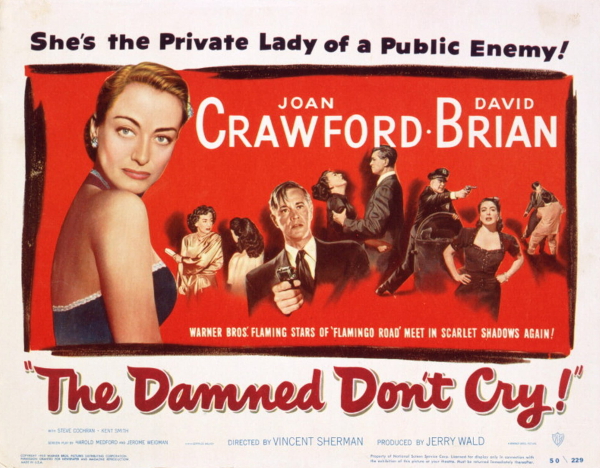









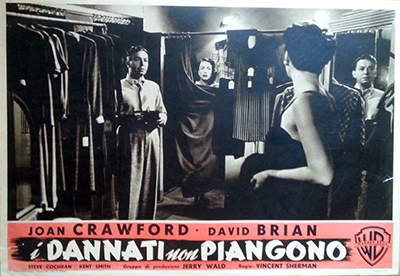
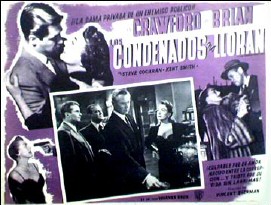
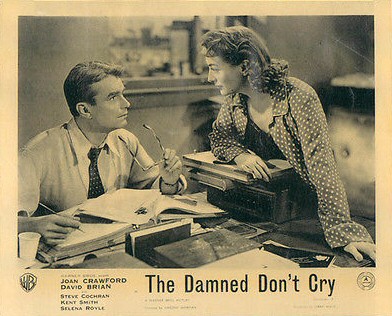
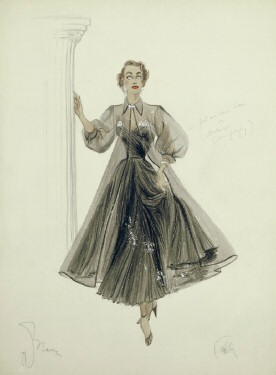
Above: Costume sketch by Sheila O'Brien.
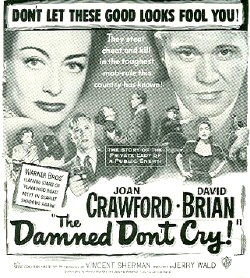
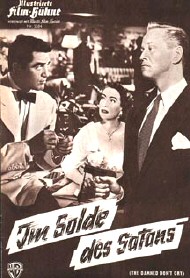
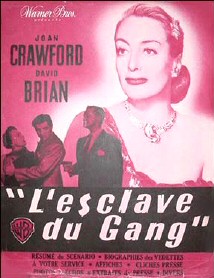
Above: US pressbook ad, German program cover, French pressbook cover.
Below: US promo and trade ad; and two newspaper ads from Springfield, Missouri.






Above: Warners promo artwork.
The Best of Everything